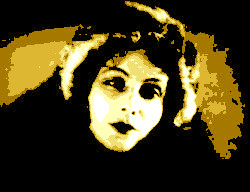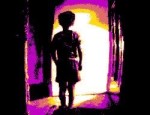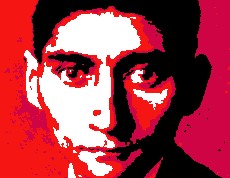Film Review
The film that set an unknown 19-year-old Swedish actress named Greta Gustafson on
the road to stardom was a brave but ultimately futile attempt by the
company Svensk Filmindistri to arrest the decline of the Swedish film
industry, after a decade in which it had been a leading player,
alongside France and the United States.
The Saga of Gosta Berling (a.k.a.
Gösta Berlings saga) is
reckoned to be Svensk's most expensive production, a sweeping romantic
melodrama of epic proportions adapted from one of Sweden's most revered
novels by the Novel Prize winning author Selma Lagerlöf. It
was the crowning achievement in the career of Mauritz Stiller, a titan
among Sweden's filmmakers, whose penchant for elaborate visual
flourishes and moody lyricism resound throughout the film. Yet,
whatever its artistic strengths, the film's main claim to fame is that
it introduced one of cinema's most enduring icons, Greta Garbo, here
credited under her adopted name for the first time in her career.
The film that was to have saved Sweden's film industry proved to be its
swansong. The
Saga of Gosta
Berling met with mixed reviews on its first release in Sweden
and was not a great success at home. It did far better on its
international release, and this was how Garbo and Stiller came to the
attention of MGM's top honcho Louis B. Mayer, the man who turned
Garbo into a screen legend and (indirectly) sent Stiller to an early grave. The
Garbo that appears in a supporting role in
The Saga of Gosta Berling is barely
recognisable as the alluring cinematic siren that the world would come
to know and love from the late 1920s onwards. Visibly overweight,
with crooked teeth and hair that looks as if it has never been near a
brush let alone hair lacquer, Garbo still manages to be an enticing
proposition, radiating an almost ethereal beauty in her mid-shots and
close-ups, and connecting with her audience with an intensity that no
one could match. How could the world not fall for such an
enchanting and devastatingly expressive creature?
The film not only helped Garbo's career, it raised the international
profile of its main star, Lars Hanson, who gives a magnetic and
magnificently energetic performance as the serial heart-breaker
Gösta Berling. Hanson's portrayal of Berling is memorably
Byronic, a classier breed of romantic hero whose lack of social grace
makes him a natural outsider in a society where strict adherence to the
book of etiquette is everything. As enjoyable as Hanson's
slightly O.T.T. performance is, it is the female characters in the
drama who are the most interesting. Of these, the most
well-rounded is the fiercely feisty Margaretha Samzelius, played with
an almost elephantine gusto by Gerda Lundequist, known in her time as
the 'Swedish Sarah Bernhardt'. When she is not knocking over the
other members of the cast like skittles, Lundequist gives a powerfully
moving portrayal of a woman who falls foul of the hypocrisies and
injustices that were rife in 19th century Swedish society.
Garbo's Elizabeth Dohna is also a victim of her rule-bound era but she
gets off comparatively lightly. Poor Samzelius loses everything -
her home, her husband, her dignity, her mother - and as she embarks on
her merciless vendetta like a crazed Horsewoman of the Apocalypse our
sympathies are entirely with her. The film should really have
been titled
The Saga of Margaretha
Samzelius.
In common with many epics of the silent era
The Saga of Gosta Berling has
suffered considerably at the hands, or rather blunt, ineffectual
scissors, of distributors attempting to maximise its commercial
value. The film originally ran to four hours and was released as
two separate films, intended to be viewed on separate evenings.
This may have been one of the reasons for the film's poor reception in
Sweden and resulted in Stiller cutting it down to a single film with a
runtime of about two hours. Further cuts were made for subsequent
releases in other countries and it was only in the 1970s that the film
was restored to its original two-part format, with footage that had
been recovered over the intervening decades. The most complete
version that is currently available runs to just over three hours.
In its restored state, it is easy to see why the film attracted mixed
reviews on its first release. The first part of the film is
languorously paced and takes its time to introduce all of the (many)
protagonists in the saga. By contrast, the second part zips along
at a phenomenal pace and includes two of the most visually impressive
set-pieces to feature in any Swedish film: the burning of Ekeby Manor
and a dazzling sequence of a sleigh being pursued across a frozen lake
by a pack of wild wolves. It is in the film's second half that
Greta Garbo comes into her own, after making only a fleeting appearance
in the first half. The aforementioned sleigh sequence in which
Hanson's attempt to abscond with Garbo ends in near disaster is a
cinematic tour de force - two puny creatures fleeing first from
humanity and then from the more fierce savagery of wolves, amid a
landscape that is as desolate as it is beautiful. This is Stiller
as his most inspired and insanely adventurous as a director - and it's
no surprise that he reserves his most powerful cinematic device, the
close-up, for the star he had created. It was via these lovingly
crafted close-ups - startling images of a vital young woman caught
between states of terror and exhilaration - that the Garbo legend was
born. It's a moment in cinematic history to savour.
© James Travers 2014
The above content is owned by frenchfilms.org and must not be copied.
Film Synopsis
A young Swedish priest, Gösta Berling, is defrocked when his
liking for the demon drink is discovered by his congregation.
Humiliated and embittered, Gösta ends up as a private tutor to
Ebba Dohna, the stepdaughter of a conniving Countess. The latter
is keen for Ebba to marry a commoner so that the girl's inheritance
will pass to her son Henrik and his Italian wife Elisabeth. When
Ebba finds out that Gösta is a discredited man of the cloth she
rejects him and he departs, his heart broken yet again. Arriving
at a neighbouring estate, Gösta is welcomed into a group of
pleasure-seeking vagabonds, the Knights of Ekeby, who are the private
amusement of the lady of the manor, Margaretha Samzelius. When,
at a party, Margaretha is inadvertently exposed as an adulteress by one
of the knights her husband is outraged and expels her from his
household. Reduced to the level of a beggar, Margaretha relishes
the day when she can have her revenge...
© James Travers
The above content is owned by frenchfilms.org and must not be copied.



